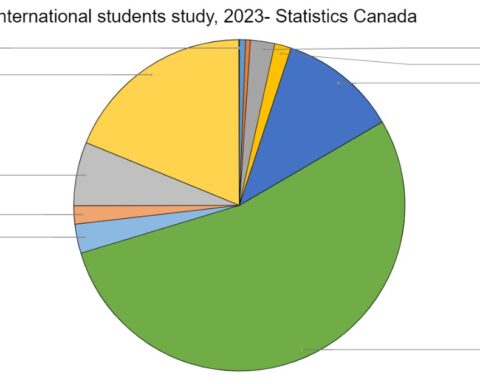This article was produced as part of an Inclusive Journalism Microcredential offered by New Canadian Media and Seneca Polytechnic. Learn more here.
Once considered a vital part of Canada’s economic recovery from the global COVID-19 pandemic, international students are facing ever tightening restrictions, leaving those who came here to fear for their future.
Niki came to Canada for a two-year 3D Animation program that started in January 2020 and two months later, the global pandemic was officially declared. (Last name withheld by request.)
In theory, she was welcomed to the country with open arms. The federal government announced in April 2021 a pathway to residency for some 40,000 international graduates of Canadian institutions who would “actively contribute” to the country’s economy.
The move was applauded by businesses at the time. In a news release on April 14, 2021 the Canadian Chamber of Commerce stated creating pathways for foreign workers and international students to permanent residence would be a long term solution for pandemic recovery.
“Today’s announcement that the government will be implementing a one-time program for recent temporary permit holders, including international students and temporary foreign workers, is an important step towards the inclusive pandemic recovery we need,” Leah Nord, senior director of workforce strategies and inclusive growth at the Canadian Chamber of Commerce, said at the time.
However, for Niki and others like her, studying and working in Canada has been difficult. She has faced three major challenges: the pandemic, an entertainment industry strike, and the advance of artificial intelligence.
“It was a limiting experience in a way that I wasn’t able to make more connections,” she said of the pandemic.
Because the animation industry thrives in a mixed professional environment, she didn’t get a chance to meet others in person including writers, producers and other aspects of entertainment production. She was limited to her classmates and the occasional support from faculty.
Luckily, work permits were readily available when she graduated January 2022, but she could only find contract and freelance work before the Screen Actors Guild-American Federation of Television and Radio Artists writer’s strike occurred, which threw her another curveball.
“The studios didn’t have any work to go on with. And with the current AI advancements and everything even after the strike has ended, there’s not a lot of jobs coming up. They don’t need that many people anymore,” she said.
According to Statistics Canada, in 2019-2020 just under 390,000 students arrived in Canada with a study permit and just under 374,000 arrived in 2020-2021. Meanwhile, 2021-2022 saw just a little over 400,000 new students admitted.
Then on Jan. 22, 2024, Immigration, Refugees and Citizenship Canada announced a two-year cap on international student permits with 360,000 for 2024.
“Today, we are announcing additional measures to protect a system that has become so lucrative that it has opened a path for its abuse.,” said Minister of Immigration, Refugees and Citizenship Marc Miller in a news conference.
Before 2024, international students only had to prove they had a minimum of $10,000 to support themselves. Moving forward, they have to prove they have more than double that at $20,635.
“It’s gotten really, really cutthroat and it’s hard,” she said. She had to get into retail work to make ends meet.
With new policies in place limiting the number of work permits available, the number of international students she will have to compete with, and the lack of thorough industry experience she could obtain due to the circumstances, she’s unsure if the government will renew her work permit in 2025.
Applying for permanent residence is not an option for her because as a gig-worker, she doesn’t meet the minimum number of hours worked in her industry. Even still, she knows of some colleagues who had their permanent residence application denied despite meeting all the requirements.
She’s planning on extending her work permit, but worries she’d be forced to move back home like a few of her other colleagues. While here, she acknowledges at this time there is no foundation built but simply survival.
“To have a family to be afforded for is out of the question. To get a house or something else will be quite impossible,” she said.
Hue Pham is an independent journalist, currently enrolled in the Journalism Master's program at Harvard University. She graduated from University of Toronto's Bachelor's program in Political Science.





